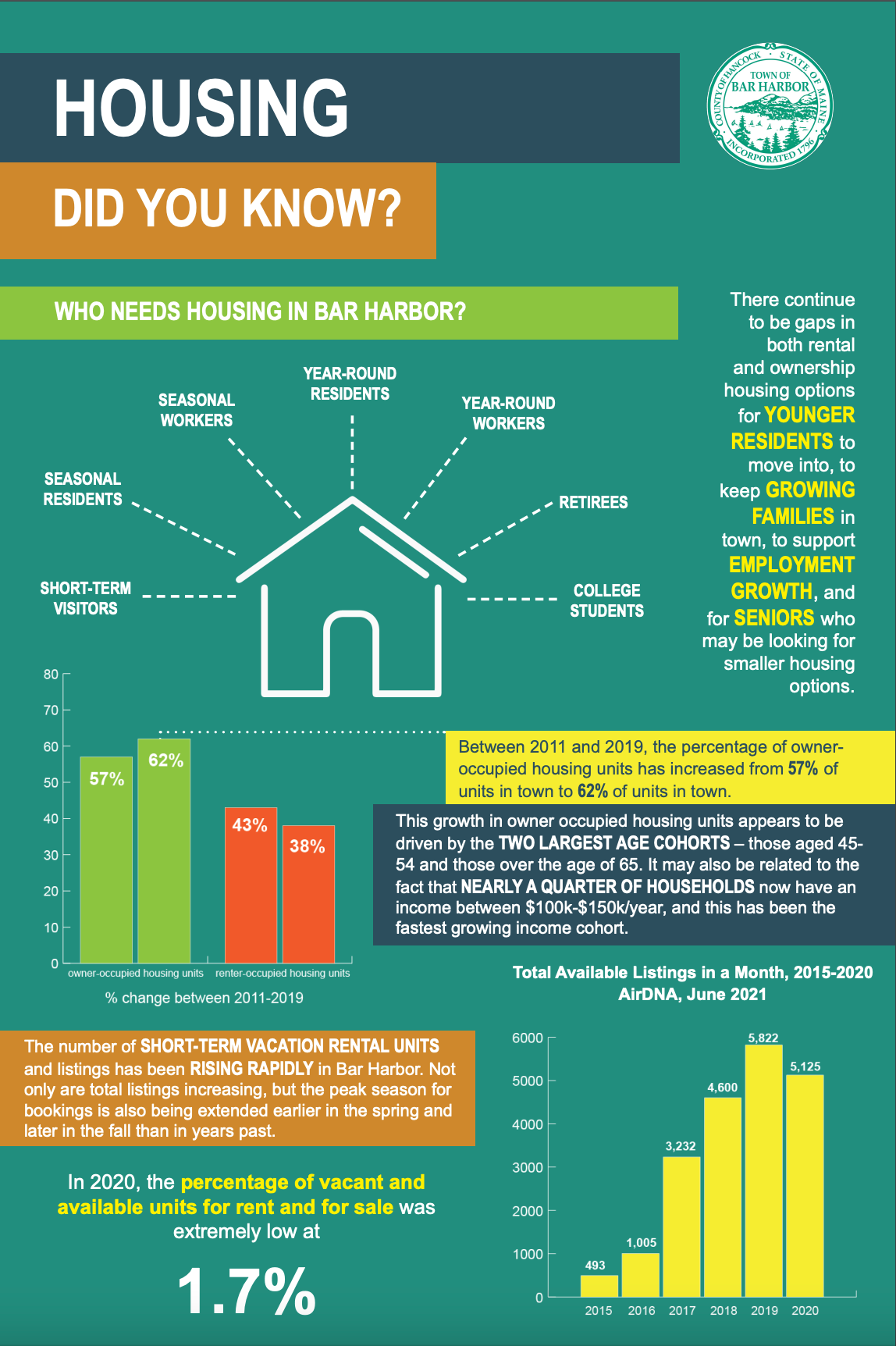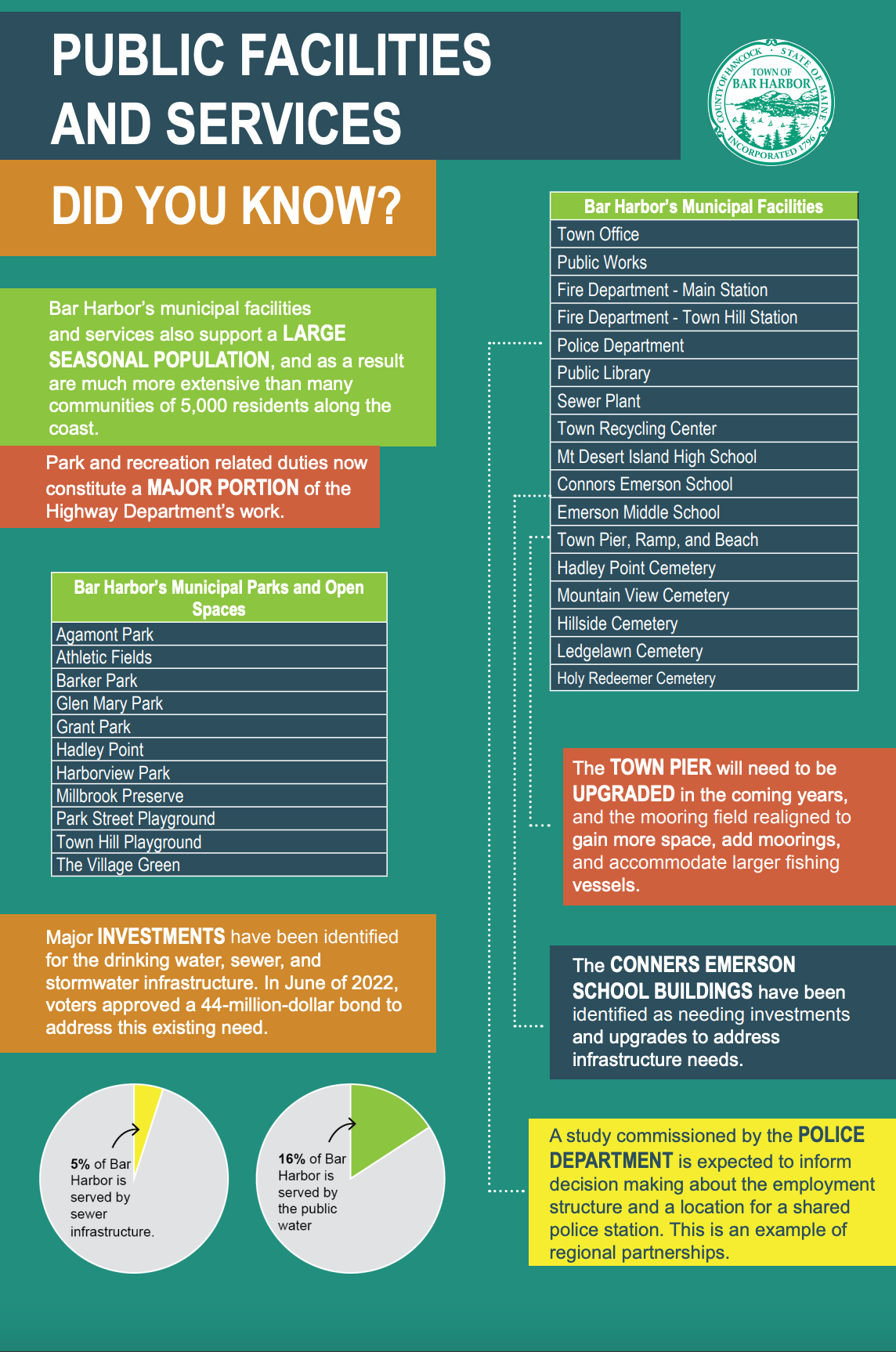Comprehensive Plan Committee Hopes For Community Participation at Two Forums
Town’s Employment, Housing, and Aging Infrastructure All Touched On
BAR HARBOR—Soon Bar Harbor mailboxes will have a bit of extra mail in it when a flyer or a postcard asking for Bar Harbor residents to come to a Bar Harbor Comprehensive Plan open house arrives. The town has two nights of open forums for people to learn about the plan and share their own thoughts via Post-its as they go from table to table.
Committee members and town staff will be there to talk to those attending.
“I’m going to be there learning as much as the people,” said committee member Greg Cox during an October 12 meeting where the committee members discussed both their duties and the recent town development report where the town and Bar Harbor Chamber of Commerce surveyed twelve builders and developers about the process of building in Bar Harbor.
Near the beginning of the meeting, Town Planner Michele Gagnon gave an overview of that recent development survey. She and staff will update the draft report and present it to the council and use it to inform the comprehensive plan as well as how the planning department proceeds and prioritizes its own goals in the next fiscal year.
Comprehensive Planning Committee Vice Chair Misha Mytar said that one of the things that was identified in that document was the lack of land area and she said that seems directly relevant to the comprehensive plan conversation. She asked if there are specific kinds of development that are permitted, but there isn’t enough land.
“There is a lack of area” and a lack of affordable land and there are restrictions on a lot of the land when it comes to development,” Gagnon said. “What we need to probably find ways to secure land” or potentially incentivize building or decrease lot size.
FORUMS AND PURPOSE OF THE PLAN
The bulk of the meeting was spent going over getting word out to the public about the forums as well as the expectations and roles of committee members at the forums and a review of forum materials that the attendees can peruse during either of the two-night events.
In the meantime there are multiple links and reports for those interested to peruse while trying to both understand the current state of Bar Harbor and its future.
According to the town’s website,
“The purpose of the new Bar Harbor Comprehensive Plan is to reflect and respond to the needs, values, and priorities of the community while safeguarding Bar Harbor’s sense of place, history, and natural resources. The new plan will serve as a guide for future growth and development, covering topics such as land use, infrastructure, natural resources, municipal services, and others. The plan will also serve as a foundation for determining effective public policy, programs, and land use decisions for the future.”
Committee members were vetted by the Appointments Committee which consists of Town Councilors Valerie Peacock, Jill Goldthwait and Jeff Dobbs. They were then voted in by the council.
The October 2022 Comprehensive Plan’s executive summary and existing analysis report both document key areas that the committee members will elucidate on and look for feedback during the two forums.
HOUSING AND EMPLOYMENT
In the plan’s executive summary, it says,
“Early in 2022, the topics of housing, infrastructure investment, tourism capacity, and the balance of the seasonal and year-round economy were identified as the top issues that Bar Harbor needs to address in the future. These priority issues were selected based on input from municipal staff, board members, and elected decision makers. They recognize that the lack of housing units and housing affordability in town is limiting who can live in the community, which impacts the composition of the community, the local economy, municipal services, and quality of life. A vibrant community is one that has housing options for a variety of people, including workers, families, seniors, low, moderate, and higher income individuals.”
At the same time, a bit more than 50 percent of the land in Bar Harbor is conserved. Another 29 percent is developed and 15 percent is undeveloped. Of this 44 percent of non-conserved land, “approximately half are impacted by environmental constraints,” the executive summary says. Most of the land is covered with forest (66 percent).
And the population is growing. A majority of the population in 2019 was over 65 (19 percent). At the same time median household income has increased between 2011 and 2019 from $17,000 to $66,591.
The housing stock is mostly single-units (71 percent). According to the report, “There are very few alternative ownership unit typologies in Bar Harbor such as townhomes, three- or four-unit structures, or larger multi-family condominiums.”
There are also more owner-occupied units, according to the report. Owner-occupied in 2019 made up 62 percent of Bar Harbor’s housing stock. That’s up from 57 percent in 2011. Similarly, units occupied by renters decreased from 43 percent to 38 percent in that time frame. “The number of short-term rentals increased from 518 in 2019 to 750 in 2021,” it said.
But according to the report, the town has 40 zoning distracts including some that are less than 250 acres. The local property value increased 27 percent in one fiscal year to $1.93 billion. Mostly because of that, the tax rate went from $11.90 (FY 2021) to $9.74 in FY 2022. However, the report says, “Although the tax rate has fallen, the property tax bill for a house valued at the town’s current median increase by about $800 a year.” Those property taxes make up about 84 percent of the town’s revenue.
“There are opportunities to refine Bar Harbor’s land use regulations to enhance flexibility of the development review process. The issues in Bar Harbor from a regulatory perspective may be less about the types of uses allowed in many districts and more about the dimensional regulations, parking, heights, and densities of residential uses.”
It goes on to say,
“The presence of large institutions and employers like MDI Hospital, College of the Atlantic, The Jackson Laboratory, and MDI Biological Laboratory are unique for a community of this size. Many employers and workers are struggling to find adequate housing in Bar Harbor and on Mount Desert Island, which results in long commute times, limits to the pool of employees that businesses can rely on, childcare challenges, and other issues. Seasonal workers are another population that has unique housing needs and limited existing opportunities to accommodate these needs.”
And about tourism, the summary states,
“The tourism-based economic sector in Bar Harbor is one of the primary drivers of employment and economic activity for the town. However, tourism is growing, and with that tensions within the community are prompting questions around the level of economic impact provided, taxes paid, amount of municipal services required, and perceived transportation and infrastructure impacts. The seasonal influx of Executive Summary - Bar Harbor Existing Conditions Analysis 5 people, particularly in Bar Harbor’s downtown, creates significant vehicle and pedestrian congestion issues, traffic safety concerns at downtown intersections, and parking capacity issues. Even with a robust seasonal public transit system and well-established vanpooling and carpooling alternatives, the reliance on automobiles is overwhelming the community’s roadways. Looking ahead, addressing congestion during peak tourism times through expanded pedestrian and bicycle infrastructure throughout the town, and increasing regional public transit alternatives will be critical.”
The executive summary also had details about Bar Harbor’s current employment situation, stating that during the pandemic 600 jobs were lost, and the unemployment rate was at 6.3 percent (2020) but has fallen since then.
During the committee meeting, members spoke multiple times about getting feedback and forum attendance from Jackson Lab employees as well as College of the Atlantic students. Town Council Chair Valerie Peacock stressed that she wanted to make sure all psychographics were covered.
INFRASTRUCTURE
The executive report says,
“Bar Harbor’s municipal infrastructure is aging and has some capacity limitations that are in need of significant investment, particularly due to the fact that Bar Harbor receives thousands of visitors a year who are attracted to Acadia National Park. This municipal infrastructure includes transportation infrastructure, the stormwater system, and water and sewer utilities. Public facilities, such as the town’s schools, are also in need of additional investment. While the tourism sector generates income (through parking and cruise ship fees) that supports municipal services, it also contributes additional costs and impacts to municipal services, such as solid waste, public safety, and water and sewer.”
The report also mentions a new police building for both Bar Harbor and Mount Desert, writing, “An upcoming study commissioned by the police department is expected to address the employment structure and a location for a shared police station with the Town of Mount Desert. Currently there are extensive building needs at Conners-Emerson School and MDI High School.
LINKS TO LEARN MORE!
Website dedicated to Bar Harbor’s Comprehensive Plan project.
A recent Polco survey about understanding community challenges.

















